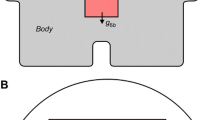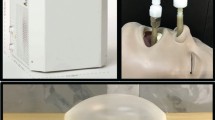Abstract
The Pennes bioheat equation and finite element method (FEM) are used to solve for the temperature distributions in the spinal cord and cerebrospinal fluid (CSF) during 30 min of cooling for spinal cord injury (SCI) patients. The average CSF and spinal cord temperatures are reduced by 3.48 and 2.72°C, respectively. The 100-mm wide pad provides the desired cooling and uses the least amount of material. The presence of zero-average CSF oscillation under normal conditions decreases the cooling extent in the spinal cord due to the introduction of warm CSF surrounding the spinal cord. The temperature decrease in the spinal cord is more than doubled when the temperature at the back of the torso is lowered from 20 to 0°C. Spinal cord ischemia, often observed after traumatic spinal cord injury, promotes cooling penetration. The proposed technique can reduce the spinal cord temperature by 2°C within 30 min and may be a feasible treatment for traumatic SCI.






Similar content being viewed by others
References
Acosta-Rua G (1970) Treatment of traumatic paraplegic patients by localized cooling of the spinal cord. J Iowa Med Soc 60:326–328
Albin M, White R, Locke G (1965) Treatment of spinal cord trauma by selective hypothermic perfusion. Surg Forum 16:423–424
Albin M, White R, Yashon D et al (1968) Functional and electrophysiologic limitations of delayed spinal cord cooling after impact injury. Surg Forum 19:423–424
Albin M, White R, Acosta-Rua G et al (1968) Study of functional recovery produced by delayed localized cooling after spinal cord injury in primates. J Neurosurg 28:113–120
Balédent O, Henry–Feugeas M, Idy-Peretti I (2001) Cerebrospinal fluid dynamics and relation with blood flow: a magnetic resonance study with semiautomated cerebrospinal fluid segmentation. Invest Radiol 36:368–377
Battin M, Penrice J, Gunn T et al (2003) Treatment of term infants with head cooling and mild systemic hypothermia (35.0°C and 34.5°C) after perinatal asphyxia. Pediatrics 111:244–251
Black P, Van Devanter S, Cohn L (1976) Current research review: effects of hypothermia on systemic and organ system metabolism and function. J Surg Res 20:49–63
Bricolo A, Ore G, Da Pian R et al (1976) Local cooling in spinal cord injury. Surg Neurol 6:101–106
Casas C, Herrera L, Prusmack C et al (2005) Effects of epidural hypothermic saline infusion on locomotor outcome and tissue preservation after moderate thoracic spinal cord contusion in rats. J Neurosurg-Spine 2:308–318
Chandrupatla T, Belegundu A (2002) Introduction to finite elements in engineering. Prentice-Hall, Upper Saddle River
Diao C, Zhu L, Wang H (2003) Cooling and rewarming for brain ischemia or injury: Theoretical analysis. Ann Biomed Eng 31:346–353
Dimar J, Shields C, Zhang Y et al (2000) The role of directly applied hypothermia in spinal cord injury. Spine 25:2294–2302
Feinburg D, Mark A (1987) Human brain motion and cerebrospinal fluid circulation demonstrated with MR velocity imaging. Radiology 163:793–799
Goetz T, Romero-Sierra C, Ethier R et al (1988) Modeling of therapeutic dialysis of cerebrospinal fluid by epidural cooling in spinal cord injuries. J Neurotraum 5:139–150
Gray H (2001) Gray’s anatomy: a facsimile. TAJ Books, London
Gül H (2007) Heat transfer in oscillating circular pipes. Exp Heat Transf 20:73–84
Hansebout R, Kuchner E, Romero-Sierra C (1975) Effects of local hypothermia and of steroids upon recovery from experimental spinal cord compression injury. Surg Neurol 4:531–536
Hansebout R, Tanner A, Romero-Sierra C (1984) Current status of spinal cord cooling in the treatment of acute spinal cord injury. Spine 9:508–511
Hansebout R, Lamont R, Kamath M (1985) The effects of local cooling on canine spinal cord blood flow. Can J Neurol Sci 12:83–87
Hausmann O (2003) Post-traumatic inflammation following spinal cord injury. Spinal Cord 41:369–378
Hemida H, Sabry M, Abdel-Rahim A et al (2002) Theoretical analysis of heat transfer in laminar pulsating flow. Int J Heat Mass Transf 45:1767–1780
Hirsch C (1988) Numerical computation of internal and external flows. John Wiley & Sons, New York
Huang P, Nian S, Yang C (2005) Enhanced heat-source cooling by flow pulsation and porous block. J Thermophys Heat Transf 19:460–470
Hulsebosch C (2002) Recent advances in pathophysiology and treatment of spinal cord injury. Adv Physiol Educ 26:238–255
Inamasu J, Nakamura Y, Ichikizaki K (2003) Induced hypothermia in experimental traumatic spinal cord injury: an update. J Neurol Sci 209:55–60
Incropera F, DeWitt D (1996) Fundamentals of heat and mass transfer, 4th edn. John Wiley and Sons, New York
Isaka M, Kumagai H, Sugawara Y et al (2006) Cold spinoplegia and transvertebral cooling pad reduce spinal cord injury during thoracoabdominal aortic surgery. J Vasc Surg 43:1257–1262
Iwai H, Mambo T, Yamamoto N et al (2004) Laminar convective heat transfer from a circular cylinder exposed to a low frequency zero-mean velocity oscillating flow. Int J Heat Mass Transf 47:4659–4672
Kwun B, Vacanti F (1995) Mild hypothermia protects against irreversible damage during prolonged spinal cord ischemia. J Surg Res 59:780–782
Leong K, Jin L (2005) An experimental study of heat transfer in oscillating flow through a channel filled with aluminum foam. Int J Heat Mass Transf 48:243–253
Li P, Yang K (2000) Mechanisms for the heat transfer enhancement in zero-mean oscillatory flows in short channels. Int J Heat Mass Transf 43:3551–3566
Loth F, Yardimci M, Alperin N (2001) Hydrodynamic modeling of cerebrospinal fluid motion within the spinal cavity. J Biomech Eng 123:71–79
Maganæs B (1989) Clinical studies of cranial and spinal compliance and the craniospinal flow of cerebrospinal fluid. Br J Neurosurg 3:659–668
Marsala M, Galik J, Ishikawa T et al (1997) Technique of selective spinal cord cooling in rat: methodology and application. J Neurosci Methods 74:97–106
Martinez-Arizala A, Green B (1992) Hypothermia in spinal cord injury. J Neurotram 9:S497–S505
Minkowycz W, Sparrow E (1997) Advances in numerical heat transfer. Taylor & Francis, Washington DC
Mori A, Ueda T, Hachiya T et al (2005) An epidural cooling catheter protects the spinal cord against ischemia injury in pigs. Ann Thorac Surg 80:1829–1834
O’Connell J (1943) Vascular factor in intracranial pressure and maintenance of cerebro-spinal fluid circulation. Brain 66:204–228
Polderman K (2004) Application of therapeutic hypothermia in the ICU: opportunities and pitfalls of a promising treatment modality. Part 1: indications and evidence. Intensive Care Med 30:556–575
Prytherch D, Smith M, Williams B (1979) The measurement of cerebrospinal fluid flow. Phys Med Biol 24:1196–1208
Reyes O, Sosa I, Kuffler D (2003) Neuroprotection of spinal neurons against blunt trauma and ischemia. Puerto Rico Health Sci J 22:277–286
Rubini L, Colombo F (1981) Modified technique for local cooling in spinal cord injuries. Spine 6:417–419
Saunders N, Habgood M, Dziegielewska K (1999) Barrier mechanisms in the brain. Clin Exp Pharmacol Physiol 26:11–19
Schellinger D, LeBihan D, Rajan S et al (1992) MR of slow CSF flow in the spine. Am J Neuroradiol 13:1393–1403
Taoka Y, Okajima K (1998) Spinal cord injury in the rat. Prog Neurobiol 56:341–358
Tator C (1972) Acute spinal cord injury: a review of recent studies of treatment and pathophysiology. Can Med Assoc J 107:143–150
Thienprasit P, Bantli H, Bloedel J et al (1975) Effect of delayed local cooling on experimental spinal cord injury. J Neurosurg 42:150–154
Tsutsumi K, Ueda T, Shimizu H et al (2004) Effect of delayed induction of postischemic hypothermia on spinal cord damage induced by transient ischemic insult in rabbits. Jpn J Thorac Cardiovasc Surg 52:411–418
Wang Y, Zhu L (2007) Targeted brain hypothermia induced by an interstitial cooling device in human neck: theoretical analyses. Eur J Appl Physiol 101:31–40
Wang L, Yan Y, Zou L et al (2005) Moderate hypothermia prevents neural cell apoptosis following spinal cord ischemia in rabbits. Cell Res 15:387–393
Wells J, Hansebout R (1978) Local hypothermia in experimental spinal cord trauma. Surg Neurol 10:200–204
Westergren H, Farooque M, Olsson Y et al (2001) Spinal cord blood flow changes following systemic hypothermia and spinal cord compression injury: an experimental study in the rat using Laser-Doppler flowmetry. Spinal Cord 39:74–84
Xian H, Liu D, Shang F et al (2007) Study on heat transfer enhancement of oscillating-flow heat pipe for drying. Dry Technol 25:723–729
Xu X, Tikuisis P, Giesbrecht G (1999) A mathematical model for human brain cooling during cold-water near-drowning. J Appl Physiol 86:265–272
Yashon D, Vise W, Dewey R et al (1973) Temperature of the spinal cord during local hypothermia in dogs. J Neurosurg 39:742–745
Zhang X, Maruyama S, Sakai S (2004) Numerical investigation of laminar natural convection on a heated vertical plate subjected to a periodic oscillation. Int J Heat Mass Transf 47:4439–4448
Zhu L (2002) Chapter 2: bioheat transfer. In: Standard handbook of biomedical engineering and design. McGraw-Hill, New York
Zhu L, Diao C (2001) Theoretical simulation of temperature distribution in the brain during mild hypothermia treatment for brain injury. Med Biol Eng Comput 39:681–687
Acknowledgments
This research was supported in part by the State of Maryland TEDCO fund, the LSAMP Bridge to the Doctorate Program, an NIGMS Initiative for Minority Student Development Grant (R25-GM55036), and Procter and Gamble. This research was performed by Katisha D. Smith in partial fulfillment of the requirements for the Ph.D. degree from the University of Maryland, Baltimore County.
Author information
Authors and Affiliations
Corresponding author
Rights and permissions
About this article
Cite this article
Smith, K.D., Zhu, L. Theoretical evaluation of a simple cooling pad for inducing hypothermia in the spinal cord following traumatic injury. Med Biol Eng Comput 48, 167–175 (2010). https://doi.org/10.1007/s11517-009-0543-z
Received:
Accepted:
Published:
Issue Date:
DOI: https://doi.org/10.1007/s11517-009-0543-z




